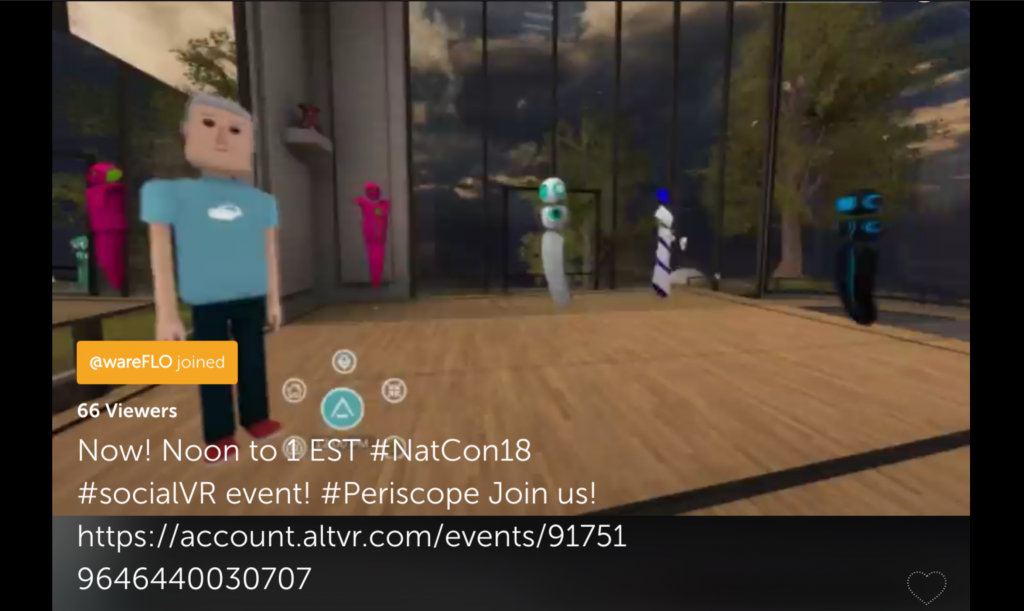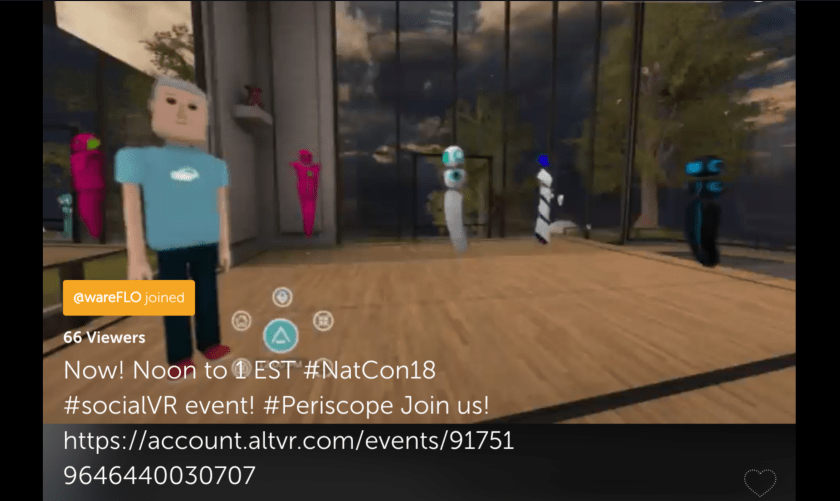Thoughts on Just Completed Behavioral Health in Social Virtual Reality Event: Personal, Respectful, Insightful
Yesterday, during the National Council for Behavioral Health Conference, I hosted a one-hour meetup about behavioral health in social virtual reality, using the @AltspaceVR social VR platform. 42 potential participants indicated their interest beforehand. I’d guestimate about 20 ultimately showed up. The conversation was excellent, a provocative mix of personal stories, research, and insight. In the following, I’ll summarize some of the most interesting moments and observations.
Today’s the day! So far 38 interested #socialVR aficionados! Noon EST! Please join us in social #VirtualReality (if you don’t have #VR headset, use free PC/Mac clients) What are your favorite #NatCon18 tweets & tweeps? What’s your behavioral health story? https://t.co/Vl5IG2kgec pic.twitter.com/wXxFVPQ5HS
— Chuck Webster Health IT Social Media Ambassador (@wareFLO) April 24, 2018
First of all, I’ll set the stage, in this case, literally! We were avatars in a virtual set. The virtual set was a large room, with (apparently) a wood floor and a large projection screen on which I displayed one of the most favorited and retweeted #NatCon18 tweets. Three walls of floor-to-ceiling windows separated us from a mountaintop park and a sky full of clouds.
“A mother writes to me, her homeless son has come in finally off the streets, in his pocket a badly worn clipping. He has circled these words, from my oped: There should be no shame in having a mental illness, only shame in not helping someone who does.” @peteearley #NatCon18
— Alicia Aebersold (@aliciacollin) April 23, 2018
Here is a tour of the virtual space I used (the same as that I used during the recent #HIMSS18 conference)…
Please enjoy a tour of our social #VirtualReality space for each of the #HIMSS18 #HIMSSVR meetups (#VR headset optimal, but not required!) Hope you can attend an event (everyday at same time: 3PM PST) https://t.co/SAX5j6BZ3S more info here https://t.co/QP2LbraZSi #HITsm #HCLDR pic.twitter.com/KZqhJAhwVW
— Chuck Webster Health IT Social Media Ambassador (@wareFLO) March 5, 2018
Our avatars are somewhat customizable. I was a brunette male in a blue shirt, almost, but not quite, a stick-figure man. But most of the other attendees appeared as floating robots. Some robots had hands that occasionally gesticulated. Heads, and therefore implied gazes, were in constant motion as we looked around at each other, depending on who was speaking, along with occasional nodding of heads in agreement. By the way, as far as I could tell, each of us was anonymous except for our AltspaceVR user handle (mine was ‘wareFLO’, the same as my Twitter handle, though I could have chosen a different AltspaceVR name to display).
About half a dozen avatars congregated and conversed. The rest wandered around, sometimes stopping to listen, and to occasionally interject or be drawn into the conversation. Others went off, some outside, gathering in what I assumed were conversations… the greater the distance between you and another avatar, the less the audio volume, just like in real life.
While I’ve occasionally hosted social VR events attended by one or two people, mostly to experiment with this new (to us) social media experience, this was the first larger scale event I’ve hosted. Frankly, I did not know what to expect. Should I be prepared to give a presentation to an audience? Should I ask people to introduce themselves? Should I just throw out questions, hoping to provoke conversation? Turns out, the last option felt most natural. I asked two or three questions about why folks came to this particular event about behavioral health, and eventually, someone answered. Which led to other folks chipping in. Which led to twisty-turny conversation, mostly about personal experiences with, and subsequent research about, such things as drug and alcohol rehabilitation as well as depression, but also about what social virtual reality has meant to each of us. One theme that came up multiple times was that anonymity behind our (to my eyes) cartoon character avatars was a plus. More than one person indicated or implied that while they were quite shy, that they were more comfortable communicating in the manner we were communicating.
By the way almost everyone was wearing a VR headset. Thus, they felt as if they were literally present in this virtual space. I found this interesting, while I have a VR headset, I was using one of the 2D desktop clients; I was the host and might have to occasionally quickly type a URL. Also, using the 2D Mac or PC clients is a great way to dip your virtual toes into AltspaceVR, prior to the expense of a compatible VR headset.
Here is how the conversation started off…
As a group, we speculated how stress might contribute to triggering mental illness episodes. We discussed how workplace culture can be oppressive when it comes to alternative lifestyles. We talked about kindling (“process by which a seizure or other brain event is both initiated and its recurrence made more likely”) in the context of alcoholism and epilepsy, which lead to a discussion of PTSD (post-traumatic stress disorder).
Then the conversation pivoted to VR technology itself, including speculations about a new generation of less expensive standalone VR headsets about to be released. Here, I took advantage of having some real VR experts present to ask a lot of questions, such as how some folks were able to have, and gesticulate with, virtual hands (requires high-end headsets and extra hand movement detection hardware) and how much that added to the VR experience. One person remarked that they gesture a lot with their hands in real-life, so it definitely feels more natural to them to be able to do in VR. Someone joked that someone was giving me a virtual massage, and I turned around to see that indeed was the case. What a strange but interesting moment that was!
Then I asked if folks saw any uses for VR in behavioral and mental health. I heard several yeses. We discussed how it is potentially easier for many people to speak to a VR avatar than a real person, even if there is a real person behind the avatar. I said I was reminded of research from decades ago about patients more comfortable about divulging sensitive information to computer interviewer. I wondered, can VR help with social anxiety? Someone noted they were afraid of public speaking, but they experience no such anxiety in social VR.
I asked if anyone had participated in the Blab group social video platform a few years ago. Some had. I noted that some folks from my Twitter social media community had really taken to Blab, but that others were resolutely resistant. I wondered if some of what we were discussing about VR and social anxiety might be relevant.
Interesting, someone raised their hand (an emoji of a hand appeared over their avatar’s head) to explain they were absolutely petrified anxious in real-world social situations but had no problem at all in social VR. (Of course, I’m thinking, wow, they had no problem raising their hand and telling us, a room full of strangers, this personal experience, wow…). Further, they believed their experience in social VR was also helping them better manage their social anxiety in the real world social situations.
We talked about VR tech again for a while…. but then again conversation returned to emotional well-being. An attendee referenced an AltspaceVR user (not at this event) who had lost his parents, and been terribly disfigured, in an automobile accident, but found great solace participating in social VR. This sort of story certainly stimulates my imagination about how social VR can help not just shy people, but folks in more extreme psychological and physical difficulty.
We eventually went past our scheduled hour by about 10 minutes. As folks took their leave, and we said our goodbyes, I felt just like when I occasionally throw a small party in the real world, and we’ve finally come to the end of the night, even though it was still 1:10 PM in the afternoon.
Here are several observations, looking back on the experience. First of all, despite anonymity, there was no troll-ish behavior, not one bit. I occasionally Periscope, and invariably have to block one or two commenters. AltspaceVR also has the ability for the host to block a participant, but I didn’t want to have to use it. Everyone seemed quite kind toward each other. In fact, I was reminded, somewhat, of group therapy sessions I participating in when I was a medical student. I hope all of my future social VR experiences are as pleasant.
Finally, the topic of Ready Player One did not come up, not even once. 
I hope I have piqued your interest in social VR, and the AltspaceVR platform. If you’d like to participate in one of my upcoming Health Systems Chats in Social VR Series of events, head on over to http://wareflo.com/socialVR!
Leave a Comment
You must be logged in to post a comment.









